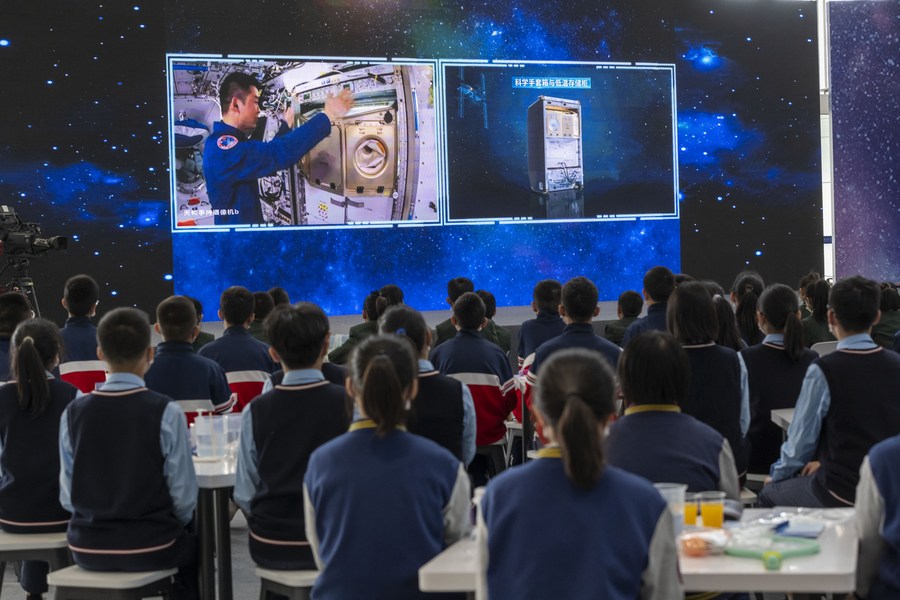Chinese astronauts give lecture from space station lab module

Students attend the third live class of the "Tiangong Class" series at Henan Museum of Science and Technology in Zhengzhou, capital of central China's Henan Province, Oct. 12, 2022. (Xinhua/Xu Jiayi)
The third live class from China's space station was held Wednesday afternoon, delivered by Shenzhou-14 crew members Chen Dong, Liu Yang, and Cai Xuzhe to students on Earth.
The main classroom is located at the Technology and Engineering Center for Space Utilization, Chinese Academy of Sciences. The class is also being attended by students from other three classrooms in Yunnan, Henan, and Shandong.
It is the first science lecture from the Wentian lab module. The previous two lectures of the "Tiangong Class" series were delivered by the Shenzhou-13 crew from the station's core module Tianhe.
The lecture content includes a capillary effect experiment, the vibration of liquid and liquid-solid mixtures, drinking water with a super-long straw, rotating and flipping wrenches, and introducing a plant growth study.
The astronauts first gave an introduction of the Wentian lab module. They noted that Wentian has an independent control system. It can take over the operation and control of the whole space station when the Tianhe core module has emergencies.
Liu showed the students the motion and vibration of liquid in a microgravity environment. She also sipped mango juice with a two-meter straw.
In another experiment, two tumbling T-handles illustrated how their motion relates to their rotation mode and mass distribution. The phenomenon, popularly known as the Dzhanibekov effect, is easier to be observed in space than on Earth.
The astronauts also had an interaction with the students and answered their questions.
A six-grader from Yunnan Province shared his germination test of Arabidopsis thaliana at school. Wearing mixed-reality glasses, Chen Dong showed the students the Arabidopsis thaliana at different stages of blooming in a microgravity science glove-box.
Arabidopsis thaliana is a model for understanding the molecular biology of plant traits in space. The science glove-box is a sealed working area in the space station where crew members can perform experimental procedures in cells and plants.
A student asked whether the astronauts feel bumps and jolts and see other spacecraft. Chen said living and working in space is smooth and steady, while they cannot see their counterparts because they are too far away from each other and in different orbits, even though the visibility in space is good.
A girl asked about the most beautiful view from space. Cai said his favorite is the atmospheric glow blanketing the Earth's horizon. Its color can change from time to time, sometimes gold, sometimes blue, and sometimes even purple.
When answering a question from a Beijing student about how to become an astronaut, Chen said that China has started selecting the fourth batch of reserve astronauts, adding that the spacecraft pilots will be recruited from the in-service pilots of the armed forces. It will be the first time to select payload specialists from the Hong Kong and Macao special administrative regions, said Chen.
"The space station is waiting for you," said Chen.
At the end of the class, the trio expressed their expectations for the students on Earth. "The Mengtian lab module will be launched into orbit soon, and we will witness the historical moment when China's space station is fully completed," Chen said. "We expect you guys to build our space home better in the future."
"The space lecture gave me a better understanding of the Wentian module and the astronauts' working and living conditions in space," said Zhang Beixi, a junior high school student from Yunnan province, who hopes to work in the country's space station when he grows up.
Wentian is the first lab module of China's under-construction space station. It was launched on July 24.
China launched the Shenzhou-14 spaceship on June 5 for a six-month mission. The crew members have conducted two extravehicular activities and been working to complete the assembly and construction of the space station, aiming to develop it from a single-module structure into a national space laboratory with three modules -- the core module Tianhe and two lab modules Wentian and Mengtian.
The Mengtian lab module has been filled with fuel as planned at the launch site, the China Manned Space Agency said on Monday.